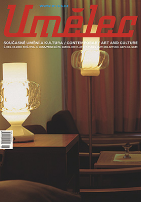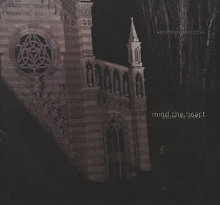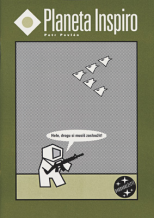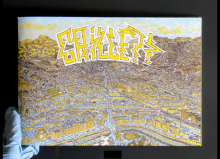| Umělec 2000/3 >> Hands in My Pockets | Просмотр всех номеров | ||||||||||||
|
|||||||||||||
Hands in My PocketsUmělec 2000/301.03.2000 Vladimir Skalnikov | review | en cs |
|||||||||||||
|
Martin Zet is the most well-known Czech artist in Russia at the moment, right after Kupka. A number of exhibitions in Moscow and St. Petersburg and long-term friendly relations with his Russian counterparts have enabled him to settle perfectly into the local artistic climate—into the background of continuous quarrels about your own civilizing identity, about whether to become a part of the consumer world, however trifling and peripheral, or whether to rely on your own, even fantasized, individuality. Or whether to find a way to emancipate and free yourself from the world order, a way that would be more successful than the Soviet model.
Martin Zet sets the example for this new openness—for everybody and everything. The alternative he suggests is called Avatars (in Russian this expression suggests associations with the words ”avant-garde/ava/ and hoity-toity, hubble-bubble) and is an incredibly tempting utopia. Its possibilities are surprisingly manifold. Zet’s utopia uses experiences from the Internet. Avatars are temporary shells for interacting participants. They are easy to build and likewise easy to destroy. They are a little bit like dominos, imaginary masques, temporary tabernacles. They do not require the reciprocal communication of participant’s permanent and definite delimitations. Those utilizing the possibility of ”reincarnation” free themselves from the unbearable burden of taking responsibility for their own actions, eliminating all duties, any socialization. The exhibition consisted of two parts: performance, and objects made up of video and slide projections, monitors with video footage and attached headphones. During his performance, Zet sealed off a door leading to the biggest room in the gallery with red tape. He then pointed a beam of light originating from a huge projector at himself, pressed his body against a wall and drew his own silhouette. Zet then hurled pre-packed snowballs at the silhouette. When the bombardment was over, Zet lit church candles in front of a large projection of his face. Then he frayed through the red tape and lit a long church candle in a square-shaped altar constructed of a fork, soupspoon, teaspoon and the candle. The visitors were then allowed to wander through the entire gallery space. The first things the viewers saw were the square altar and slide projections of smiles cut out from roughly torn newspaper photographs. At the same time, they passed along a corridor with defective passport photographs on the left side and a monitor on the right. The monitor showed video footage of a crowd at a steamboat harbor (in fact, the footage was made from the Charles Bridge [Prague]) whose atmosphere was reminiscent of impressionist themes. Attached to the video player was a set of headphones. Hidden round the corner in a dark room, just behind the monitor, was a video projection showing the artist ”ironing” with his big nose a corner between two light surfaces, similar to a lath, separating the wall from the floor. The largest room also contained a video projection—a portrait of Zet periodically deformed by simulated technical faults. Under which thin yellowish candles were burning, like those used during rituals of the Russian Orthodox Church. To the left of the portrait and above a piano, a TV monitor showed footage in which a Russian woman, soused senseless, told a poignant crime story from her life. Four monitors on the right wall—directly opposite the ”snowballed” silhouette—showed several independent stories: an adult man, conspicuously similar to Zet, punishes a child; white clouds flow by in blue sky while a light breeze blows, occasionally an airplane flies by; in a hammock, similar to the one hanging in the neighboring room with columns, a man dozes. Perhaps it’s the artist himself. Each monitor was equipped with headphones so the visitors were able to shut themselves up in intimacy and listen to a baby’s bare buttocks being slapped, the noise of a plane and the buzzing of insects… It was as if each of the projections referred to the existence of one of the worlds (and at the same time one of the reincarnations of the artist appropriate to the given world), to the mutual differences of the individual worlds and each artistic ”reincarnation,” and to the singularity and uniqueness of various contacts among individual visitors (each of them personifying the existence of another, personal life) which was emphasized by the headphones. The artist’s video icon demonstrates the instability and mutability of the image of the artist, his inclination to giving in to environmental influences and his readiness for unexpected changes in world-view. Like Krishna who gave pleasure to 17,000 of his mistresses at the same time (with each of them thinking he was attending to her alone), Martin Zet divided himself into various realities for the world and all human beings (at least the ones who came to see the exhibition). Martin Zet, Hands in my Pockets, curated by Julia Kolerova, TV Gallery, Moscow.
01.03.2000
Рекомендуемые статьи
|
|||||||||||||
|
04.02.2020 10:17
Letošní 50. ročník Art Basel přilákal celkem 93 000 návštěvníků a sběratelů z 80 zemí světa. 290 prémiových galerií představilo umělecká díla od počátku 20. století až po současnost. Hlavní sektor přehlídky, tradičně v prvním patře výstavního prostoru, představil 232 předních galerií z celého světa nabízející umění nejvyšší kvality. Veletrh ukázal vzestupný trend prodeje prostřednictvím galerií jak soukromým sbírkám, tak i institucím. Kromě hlavního veletrhu stály za návštěvu i ty přidružené: Volta, Liste a Photo Basel, k tomu doprovodné programy a výstavy v místních institucích, které kvalitou daleko přesahují hranice města tj. Kunsthalle Basel, Kunstmuseum, Tinguely muzeum nebo Fondation Beyeler.
|


































 We Are Rising National Gallery For You! Go to Kyjov by Krásná Lípa no.37.
We Are Rising National Gallery For You! Go to Kyjov by Krásná Lípa no.37.
Комментарии
Статья не была прокомментированаДобавить новый комментарий